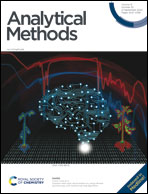A systematic approach of method development for analysis of multiple classes of emerging contaminants in wastewater: a case study of a biological nutrient removal based plant†
Abstract
Pharmaceuticals, personal care products, synthetic hormones, and industrial manufacturing additives are used worldwide, and their residues are frequently detected in wastewater. In this study, a sensitive and selective method was developed and validated for the detection and quantification of 14 Emerging Contaminants (ECs) with various physico-chemical properties frequently found in wastewater. Solid Phase Extraction (SPE) allowed for extraction and concentration of the compounds. Liquid chromatography-mass spectrometry in both positive and negative electrospray ionization mode was used for the analysis. Three different combinations of mobile phase, water + 0.1% formic acid : acetonitrile + 0.1% formic acid (3 compounds), water + 0.1% formic acid : methanol (5) and 10 mM ammonium acetate buffer : acetonitrile + 0.1% formic acid (6) gave the best chromatographic conditions to analyze the contaminants in real wastewater samples. Four different eluents at acidic and basic sample pH values were tested to optimize the SPE methodology, and three different dilution ratios (1 : 1, 2 : 1, and 5 : 1) were tested to reduce the matrix effect. Data validation was conducted using linearity, intra and inter-day repeatability, LOD/LOQ, percentage recovery, and percentage process efficiency studies. As a case study, a biological nutrient removal (BNR) based plant was tested for the presence of ECs using the developed method. Removal efficiency at different treatment stages was assessed. Most of the treatment occurred at the secondary treatment stage, whereas primary treatment and disinfection had little effect on removal. All the contaminants were found in the inlet wastewater. Estrone (E1), an endocrine disrupting compound, was reported for the first time in Indian wastewater at 376.2 ng L−1. Seven, four, and two ECs were removed at high, medium, and low efficiencies, respectively. Carbamazepine showed negative removal. This study enhanced our understanding of the occurrence and fate of several ECs in BNR based treatment systems.



 Please wait while we load your content...
Please wait while we load your content...